.

The Cadaver Synod of 897: Pope Stephen VI, aka Etienne VII, left, sitting in judgment upon the disinterred cadaver, clad in papal vestments and seated on a throne, of his predecessor, Pope Formosus, after the latter's damnatio memoriae (damnation in memory), by which all his acts and measures were annulled, all orders conferred by him were declared invalid, papal vestments were torn from his remains, three fingers of his right hand used in consecrations were sliced off, and his corpse was dumped in the Tiber (to be fished out later by a monk): Jean-Paul Laurens, 1870 (Musée de Beaux-Arts, Nantes)
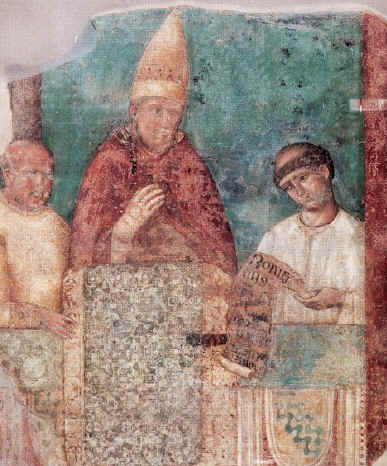
Pope Boniface VIII, portrayed by Dante in his Inferno as destined for the hell of the simoniacs though still alive at the fictional date of Dante's story; later referred to again in the same poem for his feud with the Colonnesi, which resulted in the demolition of the city of Palestrina, the murder of 6000 of its citizens and the destruction of both the home of Julius Caesar and a shrine of the Blessed Virgin Mary; here seen proclaiming the Jubilee of 1300: Giotto di Bondone, fresco in San Giovanni in Laterano, Rome, 14th c.

Pope Urban VI, aka Bartolomo Prignano, noted for his cruelty (he complained that he did not hear enough screaming when the cardinals who had conspired against him were tortured), here seen at left, shut up in the castle of Nocera, fulminating his anathemas against his besiegers with bell, book and candle: from the Croniche of Giovanni Sercanti, 16th c.
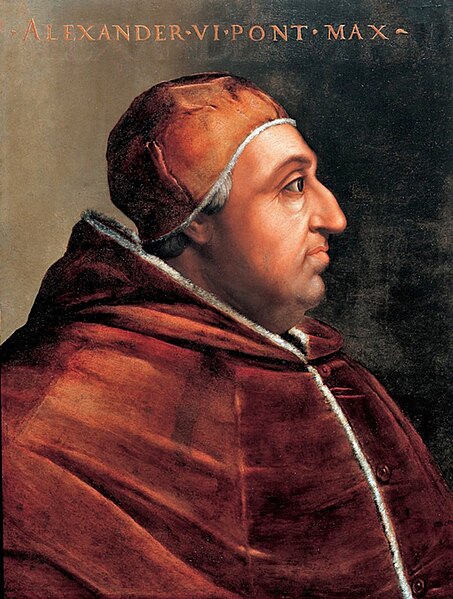
Pope Alexander VI, aka Rodrigo Borgia, who in three bulls of 1493 confirmed the Spanish monarchy's ownership of and entitlement to enslave the natives of the newly discovered lands of the Americas; a tyrannical pope who murdered and confiscated the property of any cardinal who resisted him, thus subjugating to the power of the house of Borgia the great rival houses of Orsini and Colonna; at his death, probably by poisoning, in 1503, his mouth foamed up like a kettle on the boil, his body emitted foul sulphurous gases from every orifice and became swollen to a width twice its length so that it could be jammed into a coffin only through force exerted by jumping upon the lid: Cristofano dell'Altissimo, 16th c.(Corridoio Vasariano, Florence)
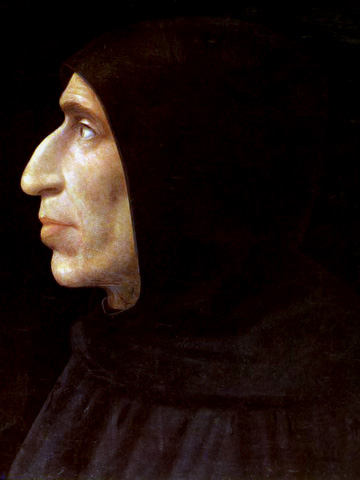
Girolamo Savonarola, arrested and executed in 1498 due to his invectives against the corrupt papacy of Alexander VI: Fra Bartolomeo, 1497 (Museo di San Marco, Florence)
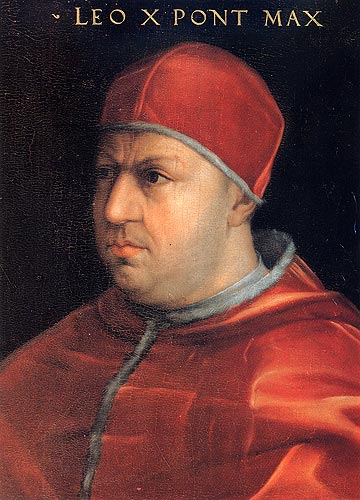
Pope Leo X, aka Giovanni di Lorenzo de' Medici, noted for his sale of indulgences to reconstruct St. Peter's Basilica; once lavished a seventh of his papal predecessors' total capital reserves on a single extravagant ceremony in Rome (detail): Raffaello Sanzio, 1518-1519 (Uffizi Gallery, Florence)

Pope Leo X, aka Giovanni di Lorenzo de' Medici, with his cousins the cardinals Giulio de' Medici (later to become Pope Clement VII) and Luigi de' Rossi: Raffaello Sanzio, 1518-1519 (Uffizi Gallery, Florence)
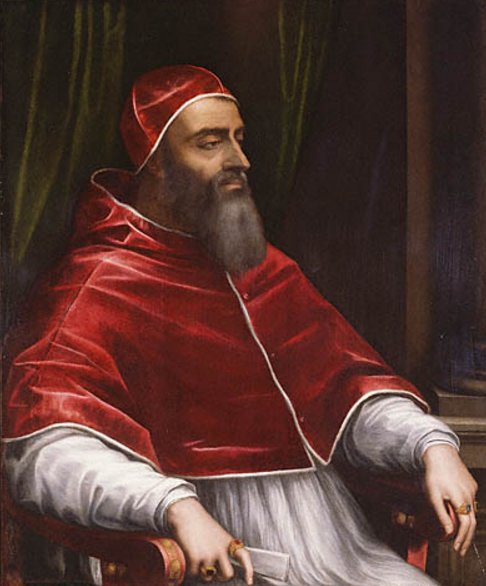
Pope Clement VII, aka Giulio di Giuliano de' Medici, whose political intriguing resulted in the sacking and pillaging of Rome in 1527: Sebastiano del Piombo, c. 1531
Historical information from E.R. Chamberlin: The Bad Popes, 1969



8 comments:
Tom,
What a cast of characters, in what stories, what pictures -- oh times, oh mors. . . .
11.2
grey whiteness of sky above still black
ridge, golden-crowned sparrow’s oh dear
in foreground, wave sounding in channel
is suggested by of, initial
impulse in which idea
to make picture which would
by read, portrait, or
silver line of sun reflected in channel,
whiteness of gull flapping toward ridge
We have just recently had a visit from the present Pope (not me personally, but the country where I reside) and your post provokes feelings within me again.
They all seem very strong characters anyway and I am liking these paintings that show such.
Oh my, strong characters they were indeed.
Let it be a matter of rejoicing, SarahA, that none of these strong characters ever visited you personally.
The matter would have had to be turned over to Snowy, in that case.
Meanwhile, let us pray...
(Election day here, I'm afraid even prayer isn't going to help against the present-day strong characters, with their millions and billions and trillions to buy votes...every politician fancying her/himself a little modern-day pope, only hope for the people is to stay out of the way and duck for cover...'twas ever thus I suppose...)
On the other hand, oh bother, let's have a laugh.
Hugs from your faithful
Thomas
Very well posted.
But you're going a bit easy on Savonarola, aren't you? The man was an absolute monster.
You're right, of course. But you know how it is when one gets caught up with these Papists. An absolute monster has a way of blending into a poor sheep.
As an RC child I was taught that papists were persecuted for no reason at all. My most memorable anti-papist experience was watching in, er... shock and awe might be the words... as our late lamented anarchist and musician friend Tuli Kupferberg (of the Fugs, may the Lord bless his soul), during the motorcade for the Pope's visit to New York in the autumn of 1967, removed his male member from his trousers and calmly and wordlessly masturbated up against the image of the Pope on the screen of the little black and white television set in the apartment of a mutual female friend (shock, awe on her part also, as can be imagined) on West Tenth Street.
This was a political statement on Tuli's part, in his way of seeing things.
Well, I suppose you'd have to have been there.
Oh, not at all! It led to my reading some interesting stories about Tuli Kupferberg.
Lordy!
Thanks for linking to this, TC; I haven't been visiting long enough to have seen it. Kupferberg's jerkin' it to Cathode Living Icon of Paulus is a revolutionary twist on passive-agressive resistance. Having only relatively quietly dodged my confirmation at 10, 11, 12, and 13-years-old, thereby making it free & clear once at public high school, I have to respect his creative approach. Cum laude, indeed.
Post a Comment